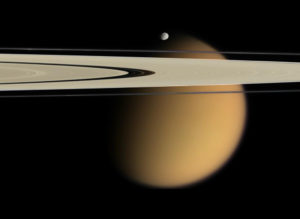- Series:Astronomy, Transcript English
Genesis 1:16-17
“And God made two great lights; the greater light to rule the day, and the lesser light to rule the night: he made the stars also. And God set them in the firmament of the heaven to give light upon the earth… “
 What could it be like to live on a space base on the surface of Titan? The sky would be either deep blue or perhaps a shade of orange under certain conditions. The base could be picturesquely situated by a lake, with a background of mountains. Perhaps a view across a plain would enable the breathtaking sight of the giant planet Saturn, with its majestic rings, hanging in the sky.
What could it be like to live on a space base on the surface of Titan? The sky would be either deep blue or perhaps a shade of orange under certain conditions. The base could be picturesquely situated by a lake, with a background of mountains. Perhaps a view across a plain would enable the breathtaking sight of the giant planet Saturn, with its majestic rings, hanging in the sky.
The atmospheric pressure would be sufficient for flying machines to operate like terrestrial airplanes, using shaped wings to provide the uplift, as a means of transport to other bases on the surface of this largest of Saturn’s moons.
But the similarities would be superficial. With the highest temperatures about -180°C (-292°F), the lakes would be of liquid methane. The base would need to be sealed against the atmosphere, which contains no oxygen. In fact, life would be bleak.
Yet it is life that encourages NASA to continue to want to explore Titan, to garner data beyond that which was collected by the Huygens mission.
NASA scientists, because of their belief in evolution, cannot comprehend that life is a phenomenon unique to the Earth. Surely, if life evolved on the Earth, then it must have evolved elsewhere, and, despite its extreme conditions, many so called “astrobiologists” think that Titan is the most likely candidate for similarly evolved life.
The Bible, on the other hand, shows us that the Earth is indeed unique. God has placed created life on this world, and we have no evidence to suggest that He put life anywhere else.
Author: Paul F. Taylor
Prayer: Wherever we go, we see Your handiwork, O Lord. The extravagance of Your divine creativity is seen in everything that You have made throughout this universe. Amen.
Ref: Return to Titan, < https://www.newscientist.com/article/mg23731700-400-return-to-titan-why-this-icy-world-is-our-best-bet-to-find-life/ >, accessed 3/27/2018. Image: Titan behind Saturn’s rings, taken from Cassini spacecraft; Public Domain (NASA
